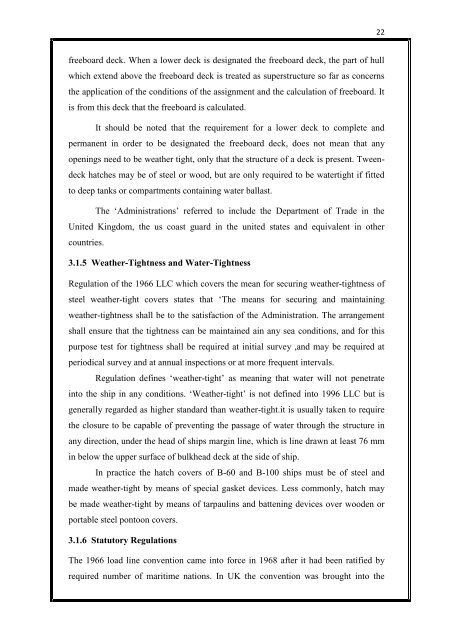Single pull macgregor type hatch cover.pdf - Cochin University of ...
Single pull macgregor type hatch cover.pdf - Cochin University of ...
Single pull macgregor type hatch cover.pdf - Cochin University of ...
Create successful ePaper yourself
Turn your PDF publications into a flip-book with our unique Google optimized e-Paper software.
freeboard deck. When a lower deck is designated the freeboard deck, the part <strong>of</strong> hull<br />
which extend above the freeboard deck is treated as superstructure so far as concerns<br />
the application <strong>of</strong> the conditions <strong>of</strong> the assignment and the calculation <strong>of</strong> freeboard. It<br />
is from this deck that the freeboard is calculated.<br />
It should be noted that the requirement for a lower deck to complete and<br />
permanent in order to be designated the freeboard deck, does not mean that any<br />
openings need to be weather tight, only that the structure <strong>of</strong> a deck is present. Tween-<br />
deck <strong>hatch</strong>es may be <strong>of</strong> steel or wood, but are only required to be watertight if fitted<br />
to deep tanks or compartments containing water ballast.<br />
The ‘Administrations’ referred to include the Department <strong>of</strong> Trade in the<br />
United Kingdom, the us coast guard in the united states and equivalent in other<br />
countries.<br />
3.1.5 Weather-Tightness and Water-Tightness<br />
Regulation <strong>of</strong> the 1966 LLC which <strong>cover</strong>s the mean for securing weather-tightness <strong>of</strong><br />
steel weather-tight <strong>cover</strong>s states that ‘The means for securing and maintaining<br />
weather-tightness shall be to the satisfaction <strong>of</strong> the Administration. The arrangement<br />
shall ensure that the tightness can be maintained ain any sea conditions, and for this<br />
purpose test for tightness shall be required at initial survey ,and may be required at<br />
periodical survey and at annual inspections or at more frequent intervals.<br />
Regulation defines ‘weather-tight’ as meaning that water will not penetrate<br />
into the ship in any conditions. ‘Weather-tight’ is not defined into 1996 LLC but is<br />
generally regarded as higher standard than weather-tight.it is usually taken to require<br />
the closure to be capable <strong>of</strong> preventing the passage <strong>of</strong> water through the structure in<br />
any direction, under the head <strong>of</strong> ships margin line, which is line drawn at least 76 mm<br />
in below the upper surface <strong>of</strong> bulkhead deck at the side <strong>of</strong> ship.<br />
In practice the <strong>hatch</strong> <strong>cover</strong>s <strong>of</strong> B-60 and B-100 ships must be <strong>of</strong> steel and<br />
made weather-tight by means <strong>of</strong> special gasket devices. Less commonly, <strong>hatch</strong> may<br />
be made weather-tight by means <strong>of</strong> tarpaulins and battening devices over wooden or<br />
portable steel pontoon <strong>cover</strong>s.<br />
3.1.6 Statutory Regulations<br />
The 1966 load line convention came into force in 1968 after it had been ratified by<br />
required number <strong>of</strong> maritime nations. In UK the convention was brought into the<br />
22

















